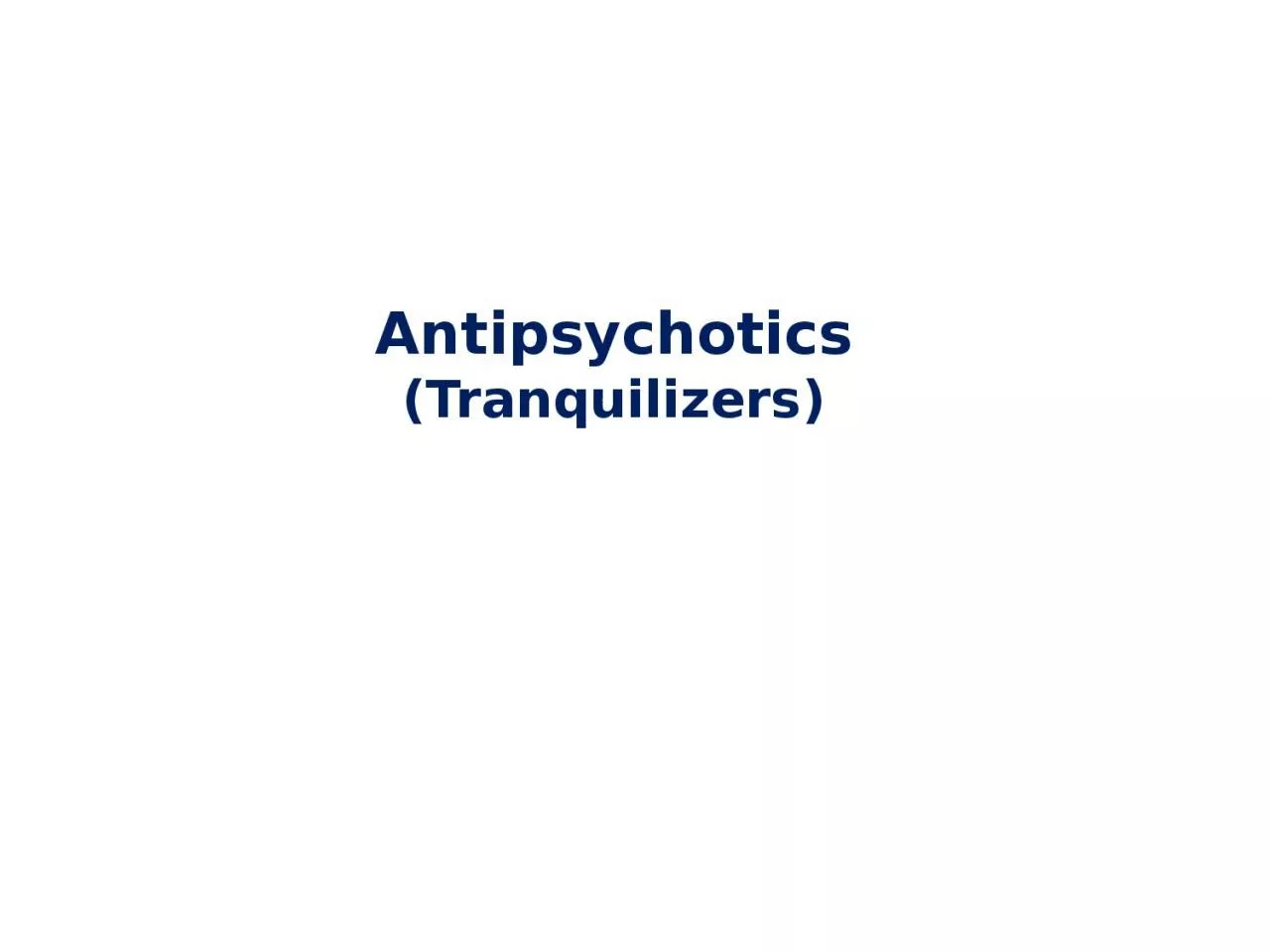

Antipsychotic drugs Antipsychotic drugs also called neuroleptics or tranquilizers are used primarily for the treatment of symptoms in mental diseases their overall influence being to free the mind from passion or disturbance and thus calm the mind ie ID: 918936
Download Presentation The PPT/PDF document "Antipsychotics (Tranquilizers)" is the property of its rightful owner. Permission is granted to download and print the materials on this web site for personal, non-commercial use only, and to display it on your personal computer provided you do not modify the materials and that you retain all copyright notices contained in the materials. By downloading content from our website, you accept the terms of this agreement.
Slide1
Antipsychotics
(Tranquilizers)
Slide2Antipsychotic drugs
•
Antipsychotic drugs (also called neuroleptics or tranquilizers) are used
primarily for the treatment of symptoms in mental diseases,
their overall influence being to free the mind from passion or disturbance and thus calm the mind i.e.,
they cause sedation without inducing sleep.
They are also effective in other psychotic states, including manic states with psychotic symptoms such as grandiosity, paranoia, and hallucinations, and delusions.
•
Antipsychotic drugs are not curative and do not eliminate the chronic thought disorder, but they often decrease the intensity of hallucinations and delusions and permit the person with schizophrenia to function in a supportive environment.
Slide3•
Tranquilizers are drugs essentially used in the management and treatment of psychoses and neuroses.• They specifically exert their action on the lower brain areas to produce emotional calmness and relaxation without appreciable hypnosis sedation.
Many of these drugs also display clinically beneficial actions like skeletal muscle relaxants, antihypertensive, antiemetic and antiepileptic properties.
Antipsychotics
may be defined as drugs which ameliorate mental aberrations (
deviation from the normal
) that are invariably characteristic features of the psychoses.
Slide4History of antipsychotic drugs
• Antipsychotic drugs have been used in Western medicine for more than 50 years.
• Chlorpromazine (1952) and Reserpine were the first drugs found to be useful in schizophrenia.
• Major novel antipsychotics are selective serotonin reuptake inhibitor and it has been introduced in 1980s.
• Little attention was paid to Cade's report in 1949 that Lithium could be used for excitement and mania: its effective use started in the 1960s and now it has a unique place in psychiatry.
Slide5Classification of antipsychotic drugs
•
PHARMACOLOGICAL CLASSIFICATION
– FIRST-GENERATION ANTIPSYCHOTIC (low potency)
• Chlorpromazine
•
Prochlorperazine • Thioridazine
– FIRST-GENERATION ANTIPSYCHOTIC (high potency)
• Fluphenazine
• Haloperidol • Pimozide • Thiothixene
– SECONDGENERATION ANTIPSYCHOTIC
•
Aripiprazole
•
Iloperidone
•
Paliperidone
•
Asenapine
•
Lurasidone
•
Quetiapine
•
Clozapine
•
Olanzapine
•
Risperidone
•
Ziprasidone
Slide6Classification of antipsychotic drugs
• CHEMICAL CLASSIFICATION
Antipsychotics
may be classified under the following categories, namely
Reserpine and Related Alkaloids:
Eg.Reserpine
,
Deserpidine
Alkylene Diols:
Eg
. Meprobamate, Tybamate
Diphenylmethane Compounds: Eg. Pipradrol, CaptodiamePhenothiazine Compounds:
Eg
. Chlorpromazine,
Perphenazine
,
Thioridazine
Dibenzazepines:
Eg
.
Loxapine
,
Clozapine
Butyrophenones:
Eg
. Haloperidol,
Droperidol
Azaspirodecanediones:
Eg
.
Buspirone
Slide7SYNTHESIS OF SOME ANTIPSYCHOTICS
Pipradrol
:
Uses:
It is used for the treatment of functional fatigue
and
various types
of depressions
Dose:
Usual, 2.5 mg twice daily.
It is synthesized by the reaction of phenyl-2-pyridyl
ketone
with phenyl magnesium
bromide (Grignard reagent) followed by catalytic reduction.
Slide8Captodiame
hydrochloride
Synthesis:
Butylphenyl thioether is first prepared by the interaction of
sodium
b
enzenethiolate
and butyl chloride.
The
resulting product on treatment with benzoyl chloride and AlCl
3
yields butyl-p-benzoyl
phenyl
thioether. This
on reaction with zinc and NaOH and carbonyl chloride yields an intermediate which on treatment with
thiourea
, NaOH, 2-dimethyl amine ethyl chloride and
HCl
gives rise to the desired product.
Slide9Uses :
It is used for the treatment of anxiety and tension.
It
is an excellent
nonhypnotic
sedative
Dose :
For anxiety and tension;
50 mg three times per day.
Slide10Chlorpromazine
Synthesis:
It is prepared by refluxing the toluene solution
of 2-chlorophenothiazine and 3-chloropropyl dimethylamine in the presence of sodamide for several hours, followed by filtration and removal of toluene under reduced pressure.
Uses:
It
is found to be effective in the management of manifestations of psychotic disorders and manic depressive illness, apprehension and anxiety and prior to surgery.
It is also used for the treatment of moderate to severe agitation.
Dose:
Adults-oral, 10 to 50 mg
2
or
3
times daily to a total
dose of 1 g daily.
Children- oral, 0.55 mg/kg every 4 to 6 hrs.